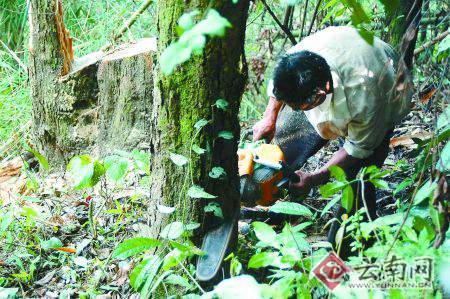A rainforest in southwest China is being felled to make room for profitable rubber plantations.
 |
|
A tree is felled within seconds in the Yunnan Province's Xishuangbanna Autonomous Prefecture. |
Every year 150,000 hectares of rainforest disappear in the Yunnan Province's Xishuangbanna Autonomous Prefecture, today's 21st Business Herald reported.
"It only takes two weeks for 10 workers to fell the trees in a wood of about 1,000 mu (667 hectares)," villager Dao Fusheng from Xishuangbanna's Hekong Village said.
"Some of the trees are cut down and sent to lumber mills. The rest are burned to be used as fertilizer for the rubber trees to be planted," he said.
The local government is planning to fell 1,667 hectares of wild forest in the village to plant rubber, he said.
Most of the trees are aged between 100 and 300 years, according to Zhang Zhengxiang, an environmental protection activist in Yunnan.
Xishuangbanna, the home to 386,667 hectares of native forest, is the only area except for Hainan Province where rubber trees can be grown in China. With the large amount of forest, the prefecture, occupying a mere 0.2 percent of China's total area, is also home to one fourth of the country's wild animals and one fifth of its wild plants.
The local government is using rubber plantations as the driver of the regional economy.
A rubber tree can sell for 200 yuan (US$29.27) and the raw rubber generated can sell for 25,000 yuan per ton, villagers told the newspaper.
Soaring rubber prices have helped the government push the rubber plantation plans through.
According to the Xishuangbanna statistics bureau, 246,667 hectares of rubber had been planted in the prefecture by the end of last year, of which 120,000 hectares had started to generate raw rubber. The figures were 3.4 percent and 5.7 percent up separately year on year.
As a result, the native forest area declined from 70 percent in 1976 to below 50 percent in 2003, with 400,000 hectares of rain forest disappearing, mostly replaced by rubber plantations, the report said.
(Shanghai Daily April 3, 2009)